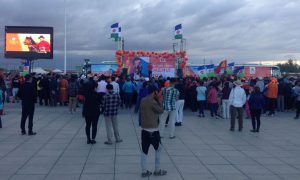By Julian Dierkes
The electoral map from Monday’s results holds a number of surprises. One of the more puzzling ones is Ganbaatar’s strong results across the Gobi region.
Umnugovi
For example, in Umnugovi fully 43% of voters supported Ganbaatar on turnout that was in line with the national rate.
Recall that Umnugovi is Mongolia’s leading mining aimag with the large projects at Oyu Tolgoi and Tavan Tolgoi. But Ganbaatar’s record shows him at least skeptical about governance arrangements for these provinces. While there may be local concerns about the impact of mining, there are also numerous jobs in this region that depend on mining and since the pre-election nation-wide surveys suggested that employment was one of the concerns foremost on Mongolians’ minds, it seems surprising to see this high rate of support.
 When we saw Ganbaatar campaign in Dalanzadgad, the event did not suggest a surge of support in the province only days before the election. While Ganbaatar turned his mining rhetoric down somewhat at the event, he still spoke about the questions he wants to raise about large mining projects.
When we saw Ganbaatar campaign in Dalanzadgad, the event did not suggest a surge of support in the province only days before the election. While Ganbaatar turned his mining rhetoric down somewhat at the event, he still spoke about the questions he wants to raise about large mining projects.
Any visit to Dalanzadgad will also show a town that might not quite be a boomtown, but that is certainly bustling, with more active markets and more modern buildings and cars than one might expect in a relatively small aimag capital of a population of less than 20,000. Of course, the total population of Umnugovi is less than 70,000 and the aimag only contributed a total of 27,000 votes, so this is a bit of a Pyrrhic victory for Ganbaatar.
Across the Region
And it wasn’t just Umnugovi. In Dundgovi, Ganbaatar received over 46% of the vote! In Dorngovi the three candidates split the vote more or less evenly. In Govi-Altai, Ganbaatar was strong in second place behind Enkbold. It was only in Bayankhongor where Battulga seemingly atoned for his 2016 parliamentary defeat with a very strong showing (60%) that Ganbaatar failed to make any inroads (10.5%).
I have yet to come across an explanation of this strength across the southern region of Mongolia. Could it be related to the lower population density somehow? More reliance on media rather than word-of-mouth or discussions with neighbours?

 Follow
Follow
I have always found Mongolians with mining and mining-sector dependent jobs (including in Gobi) to be the among, if not the, most critical of the OT agreement et al.
Might be worth taking a fine toothed comb through some of the research presented on the UCL Emerging Economy Blog with this question in mind…
Also, I’m not sure how much of this has been published, but have been hearing from anthropologists and geographers working with herders locally around Khanbogd/Bayan-Ovoo that there is a strong sense of marginalization and exclusion, that benefits of mining have been too concentrated.
Opinion: Gobi region gets the same amount of DP and MPP propaganda. But in contrast it also gets more of OT, ER, other miner interaction and community programs. Therefore there is more awareness and more personal experience to contrast what the parties are pushing and what minera are pushing. The points that Ganbaatar makes become dull and less significant to other regions, while It resonates more with Gobi population.
Yes, I would also suspect this.